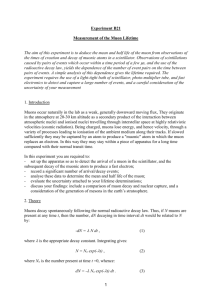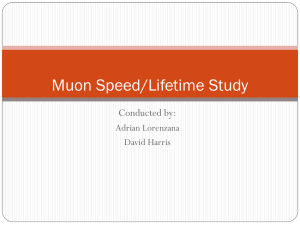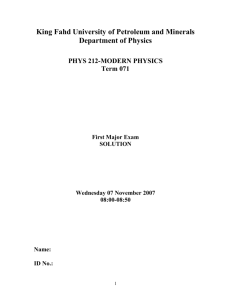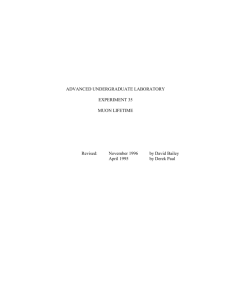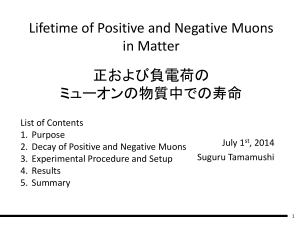muon lifetime measurement - Tata Institute of Fundamental Research
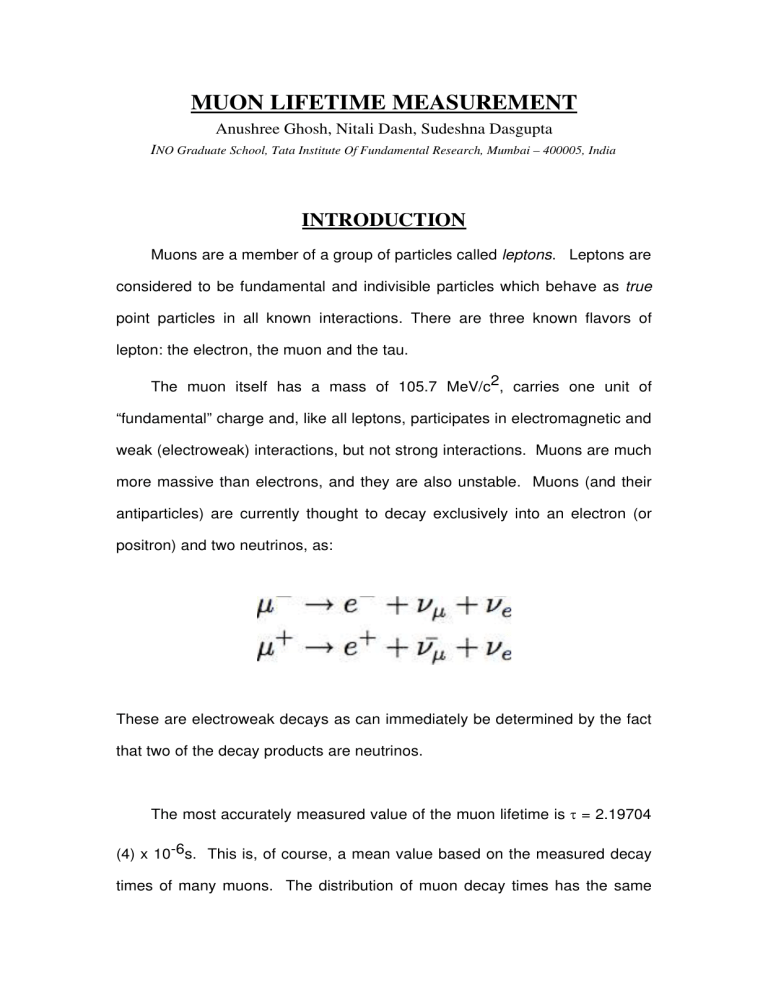
MUON LIFETIME MEASUREMENT
Anushree Ghosh, Nitali Dash, Sudeshna Dasgupta
I NO Graduate School, Tata Institute Of Fundamental Research, Mumbai – 400005, India
INTRODUCTION
Muons are a member of a group of particles called leptons . Leptons are considered to be fundamental and indivisible particles which behave as true point particles in all known interactions. There are three known flavors of lepton: the electron, the muon and the tau.
The muon itself has a mass of 105.7 MeV/c2, carries one unit of
“fundamental” charge and, like all leptons, participates in electromagnetic and weak (electroweak) interactions, but not strong interactions. Muons are much more massive than electrons, and they are also unstable. Muons (and their antiparticles) are currently thought to decay exclusively into an electron (or positron) and two neutrinos, as:
These are electroweak decays as can immediately be determined by the fact that two of the decay products are neutrinos.
The most accurately measured value of the muon lifetime is τ = 2.19704
(4) x 106s. This is, of course, a mean value based on the measured decay times of many muons. The distribution of muon decay times has the same
form as radioactive decays of nuclei and indeed the decays of all unstable elementary particles.
With an initial population of N o
muons, one will thus have
remaining muons at time t and is the lifetime of muon.
THEORY OF MUON DECAY
The cosmic radiation, which consists of high energy particles that are mostly protons, enters the earth's upper atmosphere and interacts with the atmospheric nuclei such as nitrogen or oxygen producing secondary particles.
These collisions produce mostly neutral and charged pions. Each neutral pion decay into a pair of gamma rays and the charged pions each decay into a charged muon and a muon neutrino. The muons then decay in about 2 s into an electron, a muon neutriono and an electron antineutrino.
The above decays are characterized by the following equations:
p + p
p + p+
+
+
+
e
e
e
e
The particles arriving from space are known as primary cosmic rays and the particles created in the collisions are known as secondaries. Many of the new particles are very shortlived and do not survive to reach sealevel, but positive and negative pions created in the process deacy into muons that are detectable at groundlevel. The total secondary flux at sealevel is about
1cm 2 min 1 . Roughly 75% of the flux consists of positive and negative muons and 25% of it consists of electrons and positrons.
Figure 1. Cosmic showe r
Muons have a lifetime of 2.2
s when measured in a reference frame at rest with respect to them. Given this muon lifetime and assuming a velocity close to that of light, we would find that muons could only travel a distance of about
650 m before they decayed. Hence, they could not reach the Earth from the upper atmosphere where they are produced. However, experiments show that a large number of muons do reach the Earth. The phenomenon of time
dilation explains this effect.
t = t
/ (1 v
2
/c
2
)
1/2
=
t
(where t is a time measured in the laboratory system, t´ is the time measured in the rest frame of the system, v is the velocity of the system and c is the speed of light). Relative to an observer on Earth, the muons have a lifetime equal to where = 2.2
s is the lifetime in a frame of reference traveling with the muons. For example, for v = 0.99c, = 7.08 and = 15.6
s. Hence, the average distance traveled as measured by an observer on Earth is v =
4678.62m.
EXPERIMENTAL ARRANGEMENT
The apparatus consists of a block of plastic scintillator wrapped with black paper and a photomultiplier tube(PMT). Black paper is used to prevent interaction of visible light with scintillator material. Light produced when cosmic ray muons pass through the scintillator are detected by the PMT.
Phototubes are used to guide the scintillator signal to PMT which converts the extremely weak light output of scintillator to a corresponding electrical signal. PMT is operated at high voltage of about 1.7 KV.
Figure 2. Block Diagram of Experimental Arrangement
Occassionally a cosmic ray muon stops in the scintillator resulting in two signals, first from the incoming muon and the second from the decay electron.
The timedelay between the two signals is measured using an electronic circuit and is passed to a PC for analysis and calculation of mean lifetime.
The principle of operation of scintillator and photomultiplier tube are discussed below:
SCINTILLATOR
A scintillator is a transparent material containing molecules which are excited by the passage of charged particles, and which can produce photons when the molecules subsequently decay. The number of photons produced is proportional (within statistical considerations) to the energy loss of the passing particle. Scintillation efficiency of any scintillator is defined as the fraction of incident particle energy which is converted into visible light.
Here, we have used plastic scintillator. If an organic scintillator is dissolved in a solvent, an equivalent of a solid solution is produced which is subsequently polymerized to form a solid plastic. Examples of such solvent are styrene, polyvinyltoluene, polymethylmethacrylate. Because of the ease with which they can be shaped and fabricated, plastics have become an extremely useful form of organic scintillator.
The dimension of the scintillator box used here is
24cm*24cm*14.5cm.
PHOTOMULTIPLIER TUBE
It consists of a glass vacuum tube with a photocathode, several dynodes and an anode. Incident electrons from the scintillator strike the photocathode surface with electrons being produced as a result of photoelectric effect.
These electrons are directed by focussing electrode towards electron
multiplier (consisting of dynodes) where electrons are multiplied by the process of secondary emission. Finally the electrons reach the anode where the accumulation of charge results in a sharp current pulse thus producing a strong electrical signal at the output.
Figure 3. Schematic of a PMT coupled to a scintillator
The sensitivity of photocathode is expressed in terms of quantum efficiency
(QE), which is defined as
QE = number of photoelectrons emitted
number of incident photons
The quantum efficiency should be 100% for an ideal photocathode but practically it is 2030%. It is a strong function of wavelength or quantum energy of incident light and the photocathode material.
The efficiency of a dynode is determined by the overall multiplcation factor ( ) which is expressed as
= number of secondary electrons emitted
primary incident electron
The PMT used here is of type 9807B manufactured by Electron Tubes LtD.
Diameter of the tube is 1” with a 21 pin base.
TIME MEASUREMENT CIRCUIT
PMT PULSE
When muon passes through the scintillator, it produces light signals which are fed to the PMT to produce negative pulses at the output. A pair of such pulses are shown below:
Figure 4. Output of PMT
When a muon stops in the scintillator, a short pulse of light is produced which is detected and amplified by the PMT. The output from the PMT is passed to a comparator which has the effect of filtering out noise and allowing only signals with amplitude greater than a certain threshold to pass through. If a signal is obtained at the output of the comparator, it starts a counter, counting at a rate of 10 MHz, giving a resolution of 0.1
s. If a second pulse (from the decaying muon) arrives soon after the first, the counter is stopped and the PC is signalled that data is ready to be read. The PC reads the data and resets the circuit ready for more decays. If no second pulse arrives after the first one
for a certain specified period, the circuit resets itself and waits for the next pulse to come.
THE ELECTRONIC CIRCUIT
The first stage of the circuit is highspeed comparator, LM360. Threshold for this comparator is set using a potential divider.
THRESHOLD VOLTAGE
THEORETICAL
PRACTICAL
MAX
454.54 mV
447 mV
45 mV
42 mV
MIN
Two Dtype flipflops, 74LS74, make up a state machine, using three out of four possible states. Initially both flipflops are in a cleared state, waiting for a start pulse from the PMT.
When a pulse from the PMT exceeds the threshold voltage of the comparator, a positive pulse is output to the clock pin of the first F/F. The Q output of this F/F goes high and starts a counter, counting at 10 MHz. The Q output goes low which is taken to the clock input of the second F/F. If a second pulse comes from the PMT and passes through the comparator soon after the first, the Q output of the first F/F goes low and the counter is stopped. The Q output goes high and makes the clock input of the second
F/F high. The Q output of this F/F goes low, is buffered and the signal is sent to the BUSY pin of the PC parallel port. When the PC receives the BUSY signal, the DATA_STROBE line is pulled low to enable the data buffer. The data buffer passes the count from the counter to the PC. After the PC has read the data, DATA_STROBE is taken high and the RESET line is pulled low for a microsecond. This RESET signal clears the F/Fs (back to state Waiting) and counter ready for the next signal from the PMT. If the counter reaches
255 i.e. a second pulse is not received within 25.5 s, the RC0 pin of the counter will go high. This is inverted to clear the counter and F/Fs, to wait for the next pulse from the PMT.
Description of the different ICs used in the circuit are given in the APPENDIX.
Figure 12. Electronic Circuit Diagram
DATA INTERPRETATION
When we pass the output of time measurement circuit to the PC through user port, these signals are used by a program, which calculates lifetime of each incident muon. The data is binned using a C++ program and the following plot is obtained using ROOT.
Figure 13. Plot of no. of events vs time
The parameters of the plot are obtained as follows:
NO. NAME VALUE ERROR SIZE DERIVATIVE
1 p0 5.86765e+00 1.37930e03 7.99643e07 3.60961e03
2 p1 4.52037e02 1.33554e04 6.43844e08 1.08631e01
3 p2 9.15429e+00 4.13245e01 6.90614e06 1.92942e06
4 p3 4.50130e01 3.10368e03 2.14239e06 3.21330e05 par 0 5.86765
par 1 0.0452037
par 2 9.15429
par 3 0.45013
The lifetime ( ) is obtained from the parameter 'p1' as:
p1 = (2.2122 0.0075) s
Now background events may arise due to light leakage through the scintillator, a muon passing through the scintillator without decaying or a muon comes before decay of the previous one etc.
We compensate for the background events using a polynomial of the form par[2]*(1+par[3]) which is shown as a straight line in the plot.
Calculation of Fermi Coupling Constant (G
F
)
The Fermi coupling constant plays a key role in all precision tests of electroweak standard model. It is obtained from the muon lifetime ( ) via a calculation in the Fermi model as:
G
F
2 M 5 / 192 3
G
F
= (192 3 / M 5
Using M = 105 MeV and s, we get the value of Fermi coupling constant as:
G
F
= 1.1588*10 5 GeV 2 .
REFERENCES
●
●
●
●
●
●
Glenn F. Knoll, “Radiation Detection And Measurement”.
W.R.Leo, “Techniques For Nuclear And Particle Physics Experiments”.
J.Santos, J.Augusto, A.Gomes, L.Gurriana, N.Laurenco, A.Maio,
C.Marques, J.Silva, “The CRESCRE Muon's Lifetime Experiment” .
T.Coan, T.liu, J.Ye, “A Compact Apparatus For Muon Lifetime
Measurement And Time Dilation Demonstration In The Undergraduate
Laboratory” .
Dr. F.Muheim, “Muon Lifetime Measurement”.
IC datasheets of Fairchild Semiconductor, Motorola, ST Microelectronics and National Semiconductor.
APPENDIX
IC DESCRIPTION
●
LM360
It is a very high speed differential input, complementary TTL output voltage comparator. It is an eightpin configuration IC. Connection diagram is shown in metal can package and dualinline package.
Figure 5. Metal Can Package
Figure 6. DualInLine Package
●
74LS74
It consists of high speed dual edgetriggered Dtype flipflop using schottky
TTL circuitry. It is a 14 pin configuration IC.
Figure 7. 74LS74(Logic Diagram)
I
I
Symbol
Vcc
T
A
OH
OL
Guaranteed Operating Ranges
Parameter Min Type Max
Supply Voltage 4.75
5 5.25
Operating Ambient
Temperature range 0
Output current
High
Output current
Low
2.5
70
0.4
8
V o C
Unit mA mA
●
74LS04
It is a 14 pin configuration IC containing six NOT gates.
Figure 8. 74LS04(PIN Diagram)
I
I
Symbol
Vcc
T
A
OH
OL
Guaranteed Operating Ranges
Parameter Min Type Max
Supply Voltage 4.75
5 5.25
Operating Ambient
Temperature range 0
Output current
High
Output current
Low
2.5
70
0.4
8
V o C
Unit mA mA
●
74LS541
It is a 20 pin IC, called as a buffer. It takes 4 bit output from each counter and gives 8 bit output to the PC.
Figure 9. 74LS541(PIN Diagram)
●
74LS161
It is a highspeed 4 bit synchronous counter with 16 pin configuration. It is edgetriggered, synchronously presettable and contains internal lookahead carry adder for fast counting.
Figure 10. 74LS161(Pin configuration)
I
I
Symbol
Vcc
T
A
OH
OL
Guaranteed Operating Ranges
Parameter Min Type Max
Supply Voltage 4.75
5 5.25
Operating Ambient
Temperature range 0
Output current
High
Output current
Low
2.5
70
0.4
8
V o C
Unit mA mA
●
74LS11
It is a 14 pin configuration IC consisting of triple threeinput AND gates.
Figure 11. 74LS11(Pin Diagram & Truth Table)
I
I
Symbol
Vcc
T
A
OH
OL
V
V
IH
IL
Recommended Operating Ranges
Parameter Min Nom Max
Supply Voltage 4.75
5 5.25
Operating Ambient
Temperature range 0
Output current
High
Output current
Low
Input voltage
High
Input Voltage
Low
2
70
0.4
8
0.8
mA
V
V
V o C
Unit mA
●
7805
It is a threeterminal 1A positive voltage regulator which employs internal current limiting, thermal shut down and safe operating area protection, making it essentially indestructible. If adequate heat sinking is provided, they can deliver over 1A output current
Parameter
Absolute Maximum Ratings
Symbol
Input Voltage (for V
O
= 5V to 18V) V
I
V
I (for V
O
= 24V)
Thermal Resistance JunctionCases (T O220) R JC
Thermal Resistance JunctionAir (TO220)
Operating Temperature Range (KA78XX)
Storage Temperature Range
R JA
T OPR
T STG
35
40
Value
5
65
0 ~ +125
65 ~ +150
Unit
V
V
O
C/W
O C/W
O
C
O C
It is a threeterminal negative voltage regulator with thermal overload protection and shortcircuit protection.
Input Voltage (for V
O
= 5V to 18V)
(for V
O
= 20,24V)
Output Current
Power Dissipation
Parameter
Absolute Maximum Ratings
Symbol
I
V
I
V
I
OUT
P
O
35
40
Value
Internally limited
Internally limited
Operating Temperature Range (KA78XX)
Storage Temperature Range
T OPR
T STG
0 to 150
65 to 150
O C
O
C
V
V
Unit
●
LM317
It is an adjustible three terminal positive voltage regulator designed to supply more than 1.5A of load current with an output voltage adjustible over 1.2 to
37V. It employs internal current limiting, thermal shutdown and safe area compensation.
The operating range for this IC is given in the next page.
Parameter
Absolute Maximum Ratings
Symbol
Inputoutput Voltage Differential V i
V o
40
Lead temperature
Power dissipation
Operating junction temperature range
Storage temperature range
T
P
T
T
J lead
D
STG
Temperature coefficient of Output voltage V o
/
Value
230 o C
Internally limited W
0 +125
65 +125
0.02
o
V
Unit
C o C
%/ o C
